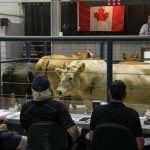Live cattle futures on the Chicago Mercantile Exchange were stronger on Monday, taking back some of Friday’s losses amid ideas the declines were overdone. Cattle futures posted limit-down losses on Friday following comments from United States President Donald Trump that he would lower beef prices. Trump also said over the weekend that beef purchases from […] Read more

U.S. livestock: Live cattle correct higher

Klassen: Cash feeder market divorces from futures market
For the week ending October 11, Western Canadian yearling markets traded $8/cwt higher to $5/cwt lower compared to seven days earlier. Calf prices experienced a week-over-week decline of $3-$8/cwt on average. Feather-light calves under 450 pounds were steady to $10 higher on average. The Canadian cash feeder market appeared to divorce from the feeder cattle […] Read more

Klassen: Highs in place for the feeder market
For the week ending October 4, Western Canadian grass yearling markets traded steady to $5-$8/cwt lower on average compared to seven days earlier. Backgrounded yearlings were down $5-$12/cwt. Calf markets were down $5 to $10/cwt from a week earlier. There was an influx of calves over the past week which resulted in the softer tone […] Read more

Klassen: Feeder market remains volatile
For the week ending September 27, Western Canadian feeder cattle markets traded $10/cwt higher to $10/cwt lower compared to seven days earlier.

Klassen: Feeder market slips off record highs
For the week ending September 20, Western Canadian feeder markets traded steady to $5/cwt lower compared to seven days earlier. There were pockets where quality calf packages traded $10-$15/cwt below prices from the prior week. The October feeder cattle futures have been trading at $15/cwt premium to the deferred March 2026 contract. This inverse in […] Read more

U.S. livestock: Cattle markets up ahead of report
Cattle futures on the Chicago Mercantile Exchange were stronger on Friday, with positioning ahead of the U.S. Department of Agriculture’s latest cattle on feed report behind much of the activity. The report came out after the markets closed, with placements in August down 10 per cent on the year at 1.78 million head and marketings […] Read more

Klassen: Feeder market eyes deferred live cattle futures
For the week ending September 13, Western Canadian feeder cattle markets were relatively unchanged compared to seven days earlier. The April 2026 live cattle futures ended the week at $233, down $10 from the contract highs. Nearby feedlot margins remain favorable; however, profitability in the deferred positions has evaporated given the weakness in the deferred […] Read more

Klassen: Feeder market consolidates at historical highs
For the week ending September 6, Western Canadian feeder cattle markets were relatively unchanged compared to seven days earlier. Alberta packers were buying fed cattle on a dressed basis at $525/cwt, up $15/cwt from a week earlier. Using a 60 per cent grading, this equates to a live price of $315/cwt. Current breakeven pen closeout […] Read more

Klassen: Feeder market continues to climb
For the week ending August 30, Western Canadian feeder cattle markets traded $4-$8/cwt higher on average. Quality yearling and calf packages were up as much as $15/cwt in some cases.

Klassen: Feeder market makes another leg higher
For the week ending August 23, Western Canadian feeder cattle markets traded $5 to $10 higher on average compared to seven days earlier. In some locations such as Lethbridge, larger packages of quality yearlings traded $10 to as much as $20/cwt higher.

